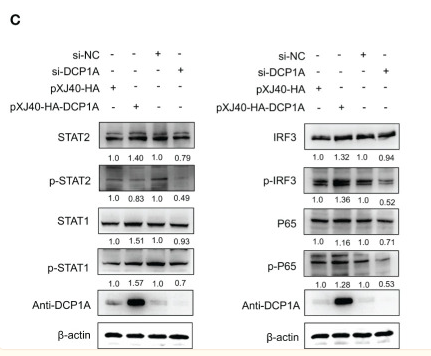Phospho-STAT2 (Tyr690) Antibody - #AF3342
| Product: | Phospho-STAT2 (Tyr690) Antibody |
| Catalog: | AF3342 |
| Description: | Rabbit polyclonal antibody to Phospho-STAT2 (Tyr690) |
| Application: | WB IHC IF/ICC |
| Cited expt.: | WB |
| Reactivity: | Human, Rat |
| Prediction: | Pig, Horse, Dog |
| Mol.Wt.: | 113kDa; 98kD(Calculated). |
| Uniprot: | P52630 |
| RRID: | AB_2834757 |
Product Info
*The optimal dilutions should be determined by the end user. For optimal experimental results, antibody reuse is not recommended.
*Tips:
WB: For western blot detection of denatured protein samples. IHC: For immunohistochemical detection of paraffin sections (IHC-p) or frozen sections (IHC-f) of tissue samples. IF/ICC: For immunofluorescence detection of cell samples. ELISA(peptide): For ELISA detection of antigenic peptide.
Cite Format: Affinity Biosciences Cat# AF3342, RRID:AB_2834757.
Fold/Unfold
Homo sapiens interferon alpha induced transcriptional activator; interferon alpha induced transcriptional activator; ISGF 3; ISGF3; MGC59816; P113; signal transducer and activator of transcription 2 113kD; Signal transducer and activator of transcription 2; STAT113; Stat2; STAT2_HUMAN;
Immunogens
A synthesized peptide derived from human STAT2 around the phosphorylation site of Tyr690.
- P52630 STAT2_HUMAN:
- Protein BLAST With
- NCBI/
- ExPASy/
- Uniprot
MAQWEMLQNLDSPFQDQLHQLYSHSLLPVDIRQYLAVWIEDQNWQEAALGSDDSKATMLFFHFLDQLNYECGRCSQDPESLLLQHNLRKFCRDIQPFSQDPTQLAEMIFNLLLEEKRILIQAQRAQLEQGEPVLETPVESQQHEIESRILDLRAMMEKLVKSISQLKDQQDVFCFRYKIQAKGKTPSLDPHQTKEQKILQETLNELDKRRKEVLDASKALLGRLTTLIELLLPKLEEWKAQQQKACIRAPIDHGLEQLETWFTAGAKLLFHLRQLLKELKGLSCLVSYQDDPLTKGVDLRNAQVTELLQRLLHRAFVVETQPCMPQTPHRPLILKTGSKFTVRTRLLVRLQEGNESLTVEVSIDRNPPQLQGFRKFNILTSNQKTLTPEKGQSQGLIWDFGYLTLVEQRSGGSGKGSNKGPLGVTEELHIISFTVKYTYQGLKQELKTDTLPVVIISNMNQLSIAWASVLWFNLLSPNLQNQQFFSNPPKAPWSLLGPALSWQFSSYVGRGLNSDQLSMLRNKLFGQNCRTEDPLLSWADFTKRESPPGKLPFWTWLDKILELVHDHLKDLWNDGRIMGFVSRSQERRLLKKTMSGTFLLRFSESSEGGITCSWVEHQDDDKVLIYSVQPYTKEVLQSLPLTEIIRHYQLLTEENIPENPLRFLYPRIPRDEAFGCYYQEKVNLQERRKYLKHRLIVVSNRQVDELQQPLELKPEPELESLELELGLVPEPELSLDLEPLLKAGLDLGPELESVLESTLEPVIEPTLCMVSQTVPEPDQGPVSQPVPEPDLPCDLRHLNTEPMEIFRNCVKIEEIMPNGDPLLAGQNTVDEVYVSRPSHFYTDGPLMPSDF
Predictions
Score>80(red) has high confidence and is suggested to be used for WB detection. *The prediction model is mainly based on the alignment of immunogen sequences, the results are for reference only, not as the basis of quality assurance.
High(score>80) Medium(80>score>50) Low(score<50) No confidence
Research Backgrounds
Signal transducer and activator of transcription that mediates signaling by type I IFNs (IFN-alpha and IFN-beta). Following type I IFN binding to cell surface receptors, Jak kinases (TYK2 and JAK1) are activated, leading to tyrosine phosphorylation of STAT1 and STAT2. The phosphorylated STATs dimerize, associate with IRF9/ISGF3G to form a complex termed ISGF3 transcription factor, that enters the nucleus. ISGF3 binds to the IFN stimulated response element (ISRE) to activate the transcription of interferon stimulated genes, which drive the cell in an antiviral state. Acts as a regulator of mitochondrial fission by modulating the phosphorylation of DNM1L at 'Ser-616' and 'Ser-637' which activate and inactivate the GTPase activity of DNM1L respectively.
Tyrosine phosphorylated in response to IFN-alpha. Phosphorylation at Ser-287 negatively regulates the transcriptional response.
'Lys-48'-linked ubiquitination by DCST1 leads to STAT2 proteasomal degradation.
Cytoplasm. Nucleus.
Note: Translocated into the nucleus upon activation by IFN-alpha/beta.
Belongs to the transcription factor STAT family.
Research Fields
· Cellular Processes > Cell growth and death > Necroptosis. (View pathway)
· Environmental Information Processing > Signal transduction > Jak-STAT signaling pathway. (View pathway)
· Human Diseases > Infectious diseases: Viral > Hepatitis C.
· Human Diseases > Infectious diseases: Viral > Hepatitis B.
· Human Diseases > Infectious diseases: Viral > Measles.
· Human Diseases > Infectious diseases: Viral > Influenza A.
· Human Diseases > Infectious diseases: Viral > Human papillomavirus infection.
· Human Diseases > Infectious diseases: Viral > Herpes simplex infection.
· Human Diseases > Cancers: Overview > Pathways in cancer. (View pathway)
· Organismal Systems > Immune system > Chemokine signaling pathway. (View pathway)
· Organismal Systems > Development > Osteoclast differentiation. (View pathway)
· Organismal Systems > Immune system > NOD-like receptor signaling pathway. (View pathway)
References
Application: WB Species: Human Sample: HEK-293T cells
Restrictive clause
Affinity Biosciences tests all products strictly. Citations are provided as a resource for additional applications that have not been validated by Affinity Biosciences. Please choose the appropriate format for each application and consult Materials and Methods sections for additional details about the use of any product in these publications.
For Research Use Only.
Not for use in diagnostic or therapeutic procedures. Not for resale. Not for distribution without written consent. Affinity Biosciences will not be held responsible for patent infringement or other violations that may occur with the use of our products. Affinity Biosciences, Affinity Biosciences Logo and all other trademarks are the property of Affinity Biosciences LTD.


